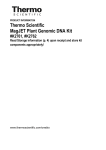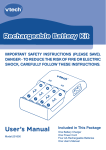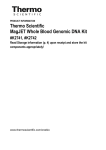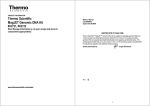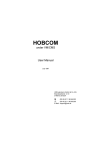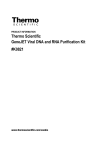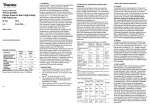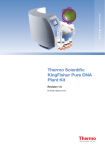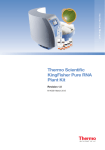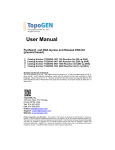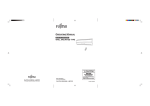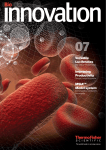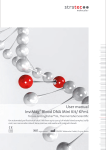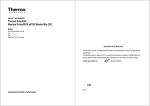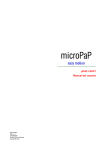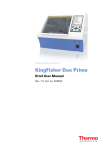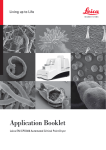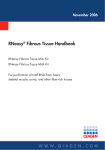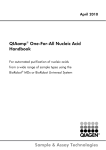Download MagJET Plant RNA Kit - Thermo Fisher Scientific
Transcript
PRODUCT INFORMATION Thermo Scientific MagJET Plant RNA Kit #K2771, #K2772 Read Storage information (p. 4) upon receipt and store kit components appropriately! www.thermoscientific.com/onebio #K2771 Lot 00000000 Exp. 00.0000 CERTIFICATE OF ANALYSIS Thermo Scientific™ MagJET™ Plant RNA Kit is qualified by isolation of total RNA from 50 mg of plant tissue following the protocol outlined in the manual. The quality of isolated RNA is evaluated spectrophotometrically and by agarose gel electrophoresis. The purified RNA has an A260/A280 ratio of 2.0±0.2 and the RNA integrity number (RIN) of ≥7. Quality authorized by: Rev.1 Jurgita Žilinskienė f 2 CONTENTS page COMPONENTS OF THE KIT ....................................................................................................4 STORAGE .................................................................................................................................4 DESCRIPTION ..........................................................................................................................4 PRINCIPLE ............................................................................................................................... 4 IMPORTANT NOTES ................................................................................................................5 ADDITIONAL MATERIALS AND EQUIPMENT REQUIRED......................................................6 AVOIDING RIBONUCLEASE CONTAMINATION .....................................................................6 RNA HANDLING AND STORAGE ............................................................................................ 6 STARTING MATERIAL HANDLING AND SAMPLE HOMOGENIZATION.................................7 PROTOCOL SELECTION GUIDE ............................................................................................. 9 TOTAL RNA PURIFICATION PROTOCOLS AND PIPETTING INSTRUCTIONS ................... 10 Protocol A. Instructions for total RNA purification from up to 50 mg plant sample using KingFisher Flex 96 and Microtiter deep well 96 plates ............................................... 10 Protocol B. Instructions for total RNA purification from up to 50 mg plant sample using KingFisher Duo with 12-pin magnet head and Microtiter deep well 96 plate .............. 12 Protocol C. Instructions for manual plant total RNA purification from up to 50 mg plant sample........................................................................................................................ 14 TROUBLESHOOTING ............................................................................................................ 15 SAFETY INFORMATION ........................................................................................................ 16 3 COMPONENTS OF THE KIT MagJET Plant RNA Kit Lysis Buffer for MagJET Plant RNA Kit MagJET Magnetic Beads DNase I (lyophilized) DNase I Reconstitution Buffer 2X DNase I Buffer Manganese Chloride Solution Wash Buffer 1 (conc.) for MagJET Plant RNA Kit Wash Buffer 2 (conc.) for MagJET Plant RNA Kit Rebinding Buffer for MagJET Plant RNA Kit Water, nuclease free #K2771 96 preps 72 mL 2 × 1.4 mL 1 vial 1 mL 12 mL 3 × 1 mL 110 mL 50 mL 20 mL 30 mL #K2772 384 preps 2 × 140 mL 10.6 mL 4 vials 2 × 1 mL 45 mL 9 × 1 mL 3 × 110 mL 3 × 50mL 70 mL 125 mL STORAGE When the kit is delivered, remove DNase I (lyophilized), DNase I Reconstitution Buffer and Manganese Chloride Solution and store at -20°C. Reconstituted DNase I should be stored at -20°C. MagJET Magnetic Beads should be stored at 4C. Other components of the kit should be stored at room temperature (15-25°C). DESCRIPTION The MagJET RNA Kit is designed for automated high throughput or manual purification of total RNA from a wide variety of plant species and tissue types. The kit utilizes paramagnetic bead technology enabling high yields and robust performance. High binding capacity, uniform particle size, and rapid magnetic response of MagJET magnetic beads makes the technology ideal for high throughput automatic nucleic acid purification, as well as for manual nucleic acid purification by low sample throughput users. The resulting high quality purified RNA is free of proteins, nucleases and other contaminants or inhibitors, and can be used in a wide range of downstream applications, such as RT-PCR, RT-qPCR and other enzymatic reactions. See Table 1 for typical total RNA yields from various sources. PRINCIPLE The MagJET Plant RNA Kit uses the highly efficient MagJET magnetic particle-based technology for nucleic acid purification. The nucleic acid isolation process combines the simple steps of sample lysis, RNA binding to the magnetic beads, DNA digestion, washing and elution. Purification protocols optimized for automated KingFisher instruments utilize a high throughput magnetic bead transfer technique, where magnetic beads are transferred through different reagent plates containing lysis, binding, washing and elution reagents. This enables high throughput nucleic acid purification and eliminates multiple pipetting steps. Alternatively, a protocol is provided where buffers and other reagents are transferred in each of the protocol steps, while magnetic beads remain captured on the wall of a tube using a magnetic rack. This allows the kit to be used in various throughput applications using a magnetic rack and manual or automated pipetting equipment. 4 Table 1. Typical yields of total RNA from various sources. Plant Tissue (50 mg) RNA yield, µg leaf leaf leaf leaf leaf leaf leaf leaf leaf seeds leaf stalk seeds leaf seeds fruit stalk stalk seeds 18-20 15-20 21-52 25-32 25-36 24-30 8-12 16-19 13-20 20-40 11-19 22-28 30 30-40 44 18 10 4-5 40 Arabidopsis thaliana Nicotiana tabacum Tomato Barley seedlings Wheat shoots Spinach Onion Rice Corn Canola (Rape) Soy Cucumber Potato Sunflower IMPORTANT NOTES Add the indicated volumes of ethanol (96-100%) to Wash Buffer 1 (conc.) and Wash Buffer 2 (conc.) prior to first use: Concentrated buffer Ethanol (96-100%) Total volume: #K2771 and #K2772 Wash Buffer 1 Wash Buffer 2 110 mL 50 mL 110 mL 200 mL 220 mL 250 mL After preparing each solution, mark the bottle to indicate that this step has been completed. To prepare the DNase I solution add 0.44 mL of DNase I Reconstitution Buffer to each vial of DNase I (lyophilized) and incubate at room temperature for 5 minutes. Occasional gentle rotation of the vial helps to dissolve the DNase I, but avoid forceful mixing. Do not vortex! Store at -20°C. Before each RNA purification, prepare a fresh aliquot of Lysis Buffer supplemented with 2 M DTT solution. Add 20 µL of 2 M DTT to each 1 mL of Lysis Buffer needed. Check all solutions in the kit for salt precipitation before each use. Re-dissolve any precipitates by warming the solution at 37 °C, and then equilibrate to room temperature (20 ± 5°C). Wear gloves when handling the Lysis Buffer, Rebinding Buffer and Wash Buffer 1 as these reagents contain irritants (see page 16 for SAFETY INFORMATION). 5 ADDITIONAL MATERIALS AND EQUIPMENT REQUIRED 2 M DTT (dithiotreitol) solution (store at -20°C). polyvinylpyrrolidone (PVP)(for RNA purification from woody, lignified and or polyphenol-rich samples, see p.7-8). Sodium chloride (NaCl) (for RNA purification from soy beans, see p.7-8). 96-100% ethanol, molecular biology grade. Pipettes and RNase-free pipette tips. 8 or 12 channel pipettes and pipette tips. RNase-free 1.5-2 mL plastic tubes. Disposable gloves. Thermomixer. Centrifuge capable of ≥ 16,000 × g for microtubes. Centrifuge capable of 3,000-4,000 × g with swinging-bucket rotor for 96-well plates. Incubator or water bath capable of 56°C. Vortex. Mortar and pestle (for manual tissue disruption in liquid nitrogen). Liquid nitrogen. Commercial homogenizer and stainless steel beads (for mechanical automatic plant tissue disruption). Automatic magnetic particle processor and consumables. For manual protocol acquire magnetic particle processing rack. AVOIDING RIBONUCLEASE CONTAMINATION RNA purity and integrity is essential for downstream applications. RNA can be degraded by RNase A, which is a highly stable contaminant found in any laboratory environment. Care must be taken not to introduce RNases into RNA preparations, especially during wash with Wash Buffer 2 and elution steps. General recommendations to avoid RNase contamination include the following: Wear gloves when handling reagents and RNA samples, as skin is a common source of RNases. Change gloves frequently. Use sterile, disposable RNase-free pipette tips. Use appropriate reagents to remove RNase contamination from nondisposable items (pipettes, centrifuges) and work surfaces. Keep all kit components tightly sealed when not in use. After usage close bottles immediately. RNA HANDLING AND STORAGE Keep the RNA on ice after extraction and while working with it. Store the extracted RNA at -20°C or -70°C. For long term use store RNA at -70°C. 6 STARTING MATERIAL HANDLING AND SAMPLE HOMOGENIZATION To minimize RNA degradation, avoid repeated freezing and thawing of the samples and perform extractions from fresh material, or material that has been immediately frozen and stored at -70°C. Appropriate sample storage is essential for reproducibility and high RNA yields. Yields of RNA may vary depending on sample age, type of sample, and storage conditions. Efficient homogenization of the sample material is an essential step before RNA purification in order to gain a good yield of high-quality RNA. The lysis procedure of plant tissue is most effective with well homogenized, powdered samples. Plant tissue can be homogenized using a mortar and pestle in the presence of liquid nitrogen or using commercial homogenizers with steel beads. Manual plant tissue homogenization 1. Place the plant sample in a mortar with liquid nitrogen. Grind the tissue using a pestle. 2. Allow the liquid nitrogen to evaporate and transfer the powder sample (10- 50 mg) into a 1.5 mL microcentrifuge tube containing 600 µL Lysis Buffer supplemented with DTT as described on page 5. Transfer the homogenized tissue to the Lysis Buffer as quickly as possible to avoid RNA degradation. All homogenized material must be thoroughly mixed with the Lysis Buffer. RNA degradation can occur in particles that are left to dry on the walls of the tube. 3. Vortex for 10-20 s to mix thoroughly. 4. Incubate for 5 min at 56°C. 5. Centrifuge for 10 min at maximum speed (≥16,000 × g). 6. Carefully take 400 µL of the cleared supernatant and immediately proceed with the RNA isolation according to protocols A - C. Notes for lysis of different plant samples: For seed samples, use 10-20 mg starting material into the Lysis Buffer. To purify total RNA from woody, lignified and or polyphenol-rich samples such as branches, twigs, needles, wax-coated leaves (such as laurel), supplement the Lysis Buffer with polyvinylpyrrolidone (PVP) at a 2% (w/v) final concentration. To purify total RNA from soy beans, supplement the Lysis Buffer with sodium chloride (NaCl) at a 2 M final concentration. 7 Mechanical (automatic) tissue disruption Plant tissue can be homogenized with commercial homogenizers and grinding mills (with stainless steel beads). High-throughput homogenizers offer a suitable method for handling up to 96 samples simultaneously. 1. Place up to 50 mg of plant sample (or up to 20 mg for seeds) into microtube containing a stainless steel bead and 600 µL Lysis Buffer supplemented with DTT as described on page 5. 2. Grind the sample according to homogenizer instructions. 3. Incubate for 5 min at 56°C. 4. Centrifuge for 10 min at maximum speed (≥16,000 × g for microtube or 3,000–4,000 × g for racked 96-well collection microtubes). 5. Carefully take 400 µL of the cleared supernatant and immediately proceed with the RNA isolation according to protocols A – C. Notes for lysis of different plant samples: Use 10-50 mg of fresh plant sample for mechanical automatic disruption (with stainless steel beads) in single microtubes*. Use 10-20 mg plant lsample for mechanical automatic disruption (with stainless steel beads) in racked 96-well collection microtubes*. Use 10-20 mg of plant seeds as starting material for mechanical automatic disruption (with stainless steel beads) in racked 96-well collection microtubes and/or single mictrotubes*. To purify total RNA from woody, lignified and or polyphenol-rich samples such as branches, twigs, needles, wax-coated leaves (e.g. laurel), supplement the Lysis Buffer with polyvinylpyrrolidone (PVP) at a 2% (w/v) final concentration. To purify total RNA from soy beans, supplement the Lysis Buffer with sodium chloride (NaCl) at a 2 M final concentration. *- Proceed according homogenizer manufacturer recommendations. 8 PROTOCOL SELECTION GUIDE The MagJET Plant RNA Kit provides optimized protocols for total RNA purification from different amounts of starting material (10-50 mg). The Kit is compatible with automated and manual sample processing, allowing high and low-throughput nucleic acid purification workflows. The following selection guide summarizes the available protocols depending on starting sample weight, throughput and sample processing method. Automation protocols are optimized for KingFisher Flex and KingFisher Duo instruments. 10-50 mg (10-20 mg of seeds) Manual processing 10-50 mg (10-20 mg of seeds) KingFisher Duo Instrument Plant homogenized with liquid nitrogen (see the detailed instruction on page 7) Plant homogenized with equipment for disrupting plant tissue* (see the detailed instruction on page 8) Sample weight KingFisher Flex Instrument Plant homogenization type Throughput per run Protocol selection guide: MagJET purification protocol Up to 96 ● - - Protocol A 10 Up to 12 - ● - Protocol B 12 variable - - ● Protocol C 14 Up to 96 ● - - Protocol A 10 Up to 12 - ● - Protocol B 12 variable - - ● Protocol C 14 *Sample quantity may depend on the homogenizer type and throughput. Please proceed according homogenizer manufacturer recommendations. 9 Page TOTAL RNA PURIFICATION PROTOCOLS AND PIPETTING INSTRUCTIONS Protocol A. Instructions for total RNA purification from up to 50 mg plant sample using KingFisher Flex 96 and Microtiter deep well 96 plates Note: When using the MagJET Plant RNA Kit for the first time, prepare working solutions of Wash Buffer 1 and Wash Buffer 2 and reconstitute DNase I as described on page 5. Transfer the Plant_RNA_Flex protocol file to the KingFisher instrument before first use. The instructions for transferring the protocol can be found in Chapter 4: “Using the software” in the BindIt Software for KingFisher Instruments version 3.2 User Manual. The protocol files for MagJET Plant RNA Kit can be found on the product web page on www.thermoscientific.com/onebio 1. Homogenize the plant samples and prepare lysates as described on page 7-8 (SAMPLE HOMOGENIZATION). 2. Prepare DNase l master mix for the number of samples to be processed. DNase l master mix for purification of one sample (200 µL): 100 µL 2X DNase l Buffer, 4 µL DNase I (reconstituted), 20 µL Manganese Chloride Solution and 76 µL nuclease free water. Aliquot prepared master mix to the DNase l plate (plate number 3, below). 3. Obtain six empty Thermo Scientific Microtiter deep well 96 plates and two empty Thermo Scientific KingFisher Flex 96 KF plates. 4. Fill the plates as follows: Plate number Plate type Plate name Content Volume per well Wash Buffer 1 (supplemented with ethanol) 700 µL DNase l master mix 200 µL 2 Microtiter deep well 96 plate Wash 1_1 3* Microtiter deep well 96 plate 4 Microtiter deep well 96 plate Wash 1_2 Wash Buffer 1 (supplemented with ethanol) 700 µL 5 Microtiter deep well 96 plate Wash 2_3 Wash Buffer 2 (supplemented with ethanol) 700 µL 6 Microtiter deep well 96 plate Wash 2_4 Wash Buffer 2 (supplemented with ethanol) 700 µL 7 KingFisher Flex 96 KF plate Elution Water, nuclease free 100 µL 8 KingFisher Flex 96 KF plate Tip plate - - DNase l *For best results, avoid storage of DNase I in 1X Reaction Buffer with MgCl2 at room temperature for extended periods of time. It is recommended to prepare the DNase I plate just prior to use. 10 5. Prepare the Sample plate (Microtiter deep well 96 plate). Add the following reagents to the Sample plate. Plate number 1 Plate type Microtiter deep well 96 plate Plate name Sample Content Volume per well Plant tissue lysate 400 µL Magnetic Beads* 25 µL Ethanol (96-100%) 400 µL *-Resuspend Magnetic Beads well by vortexing before use. 6. Place a Thermo Scientific KingFisher Flex 96 tip comb for deep well magnets on a Tip Plate (an empty KingFisher Flex 96 KF plate). 7. Start the Plant_RNA_Flex protocol with the KingFisher Flex 96 and load the plates according to the KingFisher display. After all the plates have been loaded into the instrument, the protocol will begin. 8. When the KingFisher Flex pauses at the dispense step (after the DNase l digestion, approximately 30 minutes after starting the run), remove the DNase l plate from the instrument and add 150 µL of Rebinding Buffer (concentrated) and 400 µL of ethanol (96-100%) per well to rebind the RNA. Plate number Plate type Plate name 3 Microtiter deep well 96 plate DNase l Volume per well Rebinding Buffer (conc.) 150 µL Ethanol 400 µL (96-100%) Content 9. Place the DNase l plate back into the instrument and press Start. After the pause, the protocol will continue through to completion. 10. After the protocol is complete, remove the plates according to the instructions on the KingFisher Flex display and turn off the instrument. Transfer the purified RNA from the Elution plate to a fresh RNase-free microtiter plate. Keep on ice for immediate use in downstream applications or store at -70°C. 11 Protocol B. Instructions for total RNA purification from up to 50 mg plant sample using KingFisher Duo with 12-pin magnet head and Microtiter deep well 96 plate Note: When using the MagJET Plant RNA Kit for the first time, prepare working solutions of Wash Buffer 1 and Wash Buffer 2 and reconstitute DNase I as described on page 5. Ensure you are using the KingFisher Duo 12-pin magnet head and heating block Transfer the Plant_RNA_Duo protocol file to the KingFisher instrument before first use. The instructions for transferring the protocol can be found in Chapter 4: “Using the software” in the BindIt Software for KingFisher Instruments version 3.2 User Manual. The protocol files for MagJET Plant RNA Kit can be found on product web page on www.thermoscientific.com/onebio 1. Homogenize the plant samples and prepare lysates as described on page 7-8 (SAMPLE HOMOGENIZATION). 2. Prepare DNase l master mix for the number of samples to be processed. DNase l master mix for purification of one sample (200 µL): 100 µL 2X DNase l Buffer, 4 µL DNase I (reconstituted), 20 µL Manganese Chloride Solution and 76 µL nuclease free water. Aliquot prepared master mix to the Microtiter deep well 96 plate row A (DNase l row). 3. Obtain one empty Thermo Scientific Microtiter deep well 96 plate and one Thermo Scientific KingFisher Duo Elution strip. 4. Prepare the Plant RNA plate (Microtiter deep well 96 plate). Add the following reagents to the rows. Note that row B is reserved for the tips and should be left empty. Note that row H is left empty. Plate name and type Plant RNA plate Microtiter deep well 96 plate Row Row name Content A B DNase l Tip C* Sample DNase l master mix 12-tip comb Plant tissue lysate Magnetic Beads Ethanol (96-100%) Wash Buffer 1 Wash Buffer 1 Wash Buffer 2 Wash Buffer 2 Empty D E F G H Wash 1_1 Wash 1_2 Wash 2_3 Wash 2_4 Empty Sample/reagent volume per well 200 µL N/A 400 µL 25 µL 400 µL 700 µL 700 µL 700 µL 700 µL Empty Note: For best results avoid storing DNase l master mix at room temperature for long-term. It is recommended to prepare the DNase l row A after filling Wash buffers rows D, E, F, G. *It is recommended to prepare the Sample row C last. 12 5. Fill the KingFisher Duo Elution strip as follows. Elution strip KingFisher Duo Elution strip Content Volume per well Water, nuclease free 100 µL 6. Place a Thermo Scientific KingFisher Duo 12-tip comb into row B on the Plant RNA plate. 7. Switch on the KingFisher Duo instrument and ensure you are using the KingFisher Duo 12-pin magnet head and heating block. Start the Plant_RNA_Duo protocol. Insert the Plant RNA plate and Elution strip into the instrument as indicated on the KingFisher Duo display and press START. Make sure that the Elution strip is placed in the correct direction into the elution block; ensure that the perforated end is facing toward the user. 8. When the KingFisher Duo pauses at the dispense step (after the DNase l digest, approximately 30 minutes after starting the run), remove the Plant RNA plate from the instrument and add 150 µL of Rebinding Buffer (concentrated) and 400 µL ethanol (96100%) per well to row A (DNase l row) to rebind the RNA. Plate name and type Plant RNA plate Microtiter deep well 96 plate Row Row name A DNase l Content Volume per well Rebinding Buffer (conc.) 150 µL Ethanol (96-100%) 400 µL 9. Place the Plant RNA plate back into the instrument and press OK. After the pause, the protocol will continue through to completion. 10. After the run is complete, remove the Plant RNA plate and Elution strip according to the instructions on the KingFisher Duo display and turn off the instrument. Transfer the purified RNA from the Elution strip to a fresh RNase-free microtiter plate or microcentrifuge tubes. Keep on ice for immediate use in downstream applications or store at -70C. 13 Protocol C. Instructions for manual plant total RNA purification from up to 50 mg plant sample Following this protocol is based on the transfer of liquids by pipetting through different purification steps rather than magnetic bead transfer as in the KingFisher automatic protocols. This allows the kit to be used in various throughput applications using a magnetic rack and manual or automated pipetting equipment. Protocols for automated pipetting platforms should be optimized for each platform and sample type. To enable protocol optimization, all buffers are available for purchase separately. Note: When using the MagJET Plant RNA Kit for the first time, prepare working solutions of Wash Buffer 1 and Wash Buffer 2 and reconstitute DNase I as described on page 5. 1. Homogenize the plant samples and prepare lysates as described on page 7-8 (SAMPLE HOMOGENIZATION). 2. Carefully transfer 400 μL of lysate supernatant to a clean microcentrifuge tube. 3. Binding to magnetic beads: add 25 μL MagJET Magnetic beads resuspended well by vortexing and 400 μL 96-100% ethanol. Vortex the tube and briefly spin to remove droplets from the inside of the lid. Place the tube on the magnetic stand and let the magnetic beads collect at the magnet for 2-3 minutes (or until the solution clears). Discard the supernatant using a pipette. 4. Wash 1: remove the tube from the magnetic stand and add 700 μL Wash Buffer 1 (supplemented with ethanol, see page 5). Resuspend the magnetic beads by vortexing, briefly spin, then place the tube on the magnetic stand and let the magnetic beads collect at the magnet for 2-3 minutes. Discard the supernatant using a pipette. 5. Dry: leave the tube on the magnetic rack for 5 minutes to dry the magnetic beads at room temperature. Remove the tube from the magnetic rack. 6. DNase I treatment: add 200 µL of DNase I solution for each purification (mix 100 µL 2X DNase I Buffer, 4 µL DNase I (reconstituted), 20 µL Manganese Chloride Solution and 76 µL nuclease free water. Prepare common mix for all samples to be processed). Mix and incubate in the thermomixer at 37°C and 350 rpm for 15 minutes. 7. Rebinding to magnetic beads: after DNase I treatment, add 150 µL of Rebinding Buffer (concentrated) and 400 µL 96-100% ethanol. Resuspend the magnetic beads by vortexing and briefly spin to remove droplets from the inside of the lid. Place the tube on the magnetic stand and let the magnetic beads collect at the magnet for 2-3 minutes. Discard the supernatant using a pipette. 8. Wash 2: remove the tube from the magnetic stand and add 700 μL Wash Buffer 1 (supplemented with ethanol, see page 5). Resuspend the magnetic beads by vortexing, place the tube on the magnetic stand and let the magnetic beads collect at the magnet for 2-3 minutes. Discard the supernatant using a pipette. 9. Wash 3: remove the tube from the magnetic stand and add 700 μL Wash Buffer 2 (supplemented with ethanol, see page 5). Resuspend the magnetic beads by vortexing, place the tube on the magnetic stand and let the magnetic beads collect at the magnet for 2-3 minutes. Discard the supernatant using a pipette. 10. Wash 4: repeat step 9 using 700 μL of Wash Buffer 2. Make sure that all the supernatant is completely removed in the last washing step. 11. Dry: leave the tube on magnetic rack for 5 min to dry the magnetic beads at room temperature. Remove the tube from the magnetic rack. 12. Elution: add 100 µL Nuclease free water. Resuspend the magnetic beads by vortexing, briefly spin, then place the tube on the magnetic stand and let the magnetic beads collect at the magnet for 2-3 minutes. 13. While on the magnetic stand, transfer the eluate (which contains the purified RNA) to a new RNase free tube, then close immediately. Keep on ice for immediate use in downstream applications or store at -70°C. 14 TROUBLESHOOTING Problem Low yield of purified RNA Purified RNA is degraded Inhibition of downstream enzymatic reactions Genomic DNA contamination Carryover of the magnetic beads in the elution Possible cause and solution RNA degraded during sample storage. Make sure the plant samples were properly stored and make sure the samples were processed immediately after collection or removal from storage. Insufficient homogenization of plant material. To disrupt the cell wall, it is important to homogenize the sample thoroughly until it is ground to a fine powder. Ethanol was not added to the lysate. Ensure that ethanol was added to the lysate during bindind to magnetic beads step. Incomplete resuspension of magnetic particles. Resuspend the magnetic particles by vortexing before use. Ethanol was not added to Wash Buffer 1: add ethanol to Wash buffer 1 as described on page 5. Ethanol was not added to Wash Buffer 2: ensure that ethanol was added to Wash Buffer 2 as described on page 5. Rebinding step was missed: ensure that rebinding buffer and ethanol was added after DNase l treatment. Loss of magnetic beads during purification: use sufficient magnetic beads capture time, be careful not remove magnetic beads during procedures. RNase contamination. To avoid RNase contamination wear gloves during the procedure and change gloves frequently. Use sterile, disposable RNase-free pipette tips. Use reagents designed to remove RNase contamination from nondisposable items (pipettes, centrifuges) and work surfaces. RNA degraded during sample storage. Make sure the plant samples were properly stored and make sure the samples were processed immediately after collection or removal from storage. RNA degraded during sample homogenization. To minimize RNA degradation, avoid repeated freezing and thawing of the samples and perform extractions from fresh material or material that has been immediately frozen and stored at -70°C. Transfer the ground tissue to the Lysis Buffer for MagJET Plant RNA Kit as quickly as possible to avoid RNA degradation. All ground material must be thoroughly mixed with the Lysis Buffer for MagJET Plant RNA. RNA degradation can occur in particles that are left to dry on the walls of the tube. Lysis Buffer was not supplemented with DTT. Ensure that 2 M DTT solution has been added to the Lysis Buffer before RNA purification procedure. Purified RNA was not stored properly. Purified RNA should be used immediately in downstream applications or stored at -20°C for later use. For prolonged storage (more than 1 month) storage at -70°C is recommended. Purified RNA contains residual salt. Use the correct order of Wash Buffers steps. Always wash the magnetic beads with Wash Buffer 1 first and then proceed with Wash Buffer 2. Purified RNA contains residual ethanol. It is important to dry magnetic beads before elution step. Inefficient DNase I digestion. Ensure that the temperature of DNase I digestion is 37°C. Prepare DNase I mix according to protocol (see p. 7 and p. 10). Too much sample input: if starting amount of plant sample is too high (> 50 mg), the DNA digestion step may not be effective. Carryover of magnetic beads in the eluted RNA will not affect downstream applications. To remove the carryover from eluted RNA, simply magnetize the magnetic beads and carefully transfer eluate to a new tube or plate. 15 SAFETY INFORMATION Lysis Buffer for MagJET Plant RNA Kit Xn Harmful Hazard-determining components of labelling: guanidinium thiocyanate Risk phrases: R20/21/22: Harmful by inhalation, in contact with skin and if swallowed. R32-52/53: Contact with acids liberates very toxic gas. Harmful to aquatic organisms, may cause long-term adverse effects in the aquatic environment. Precautionary statements P261 Avoid breathing dust/fume/gas/mist/vapours/spray. P280 Wear protective gloves/protective clothing/eye protection/face protection. P305+P351+P338 IF IN EYES: Rinse cautiously with water for several minutes. Remove contact lenses, if present and easy to do. Continue rinsing. P301+P312 IF SWALLOWED: Call a POISON CENTER or doctor/physician if you feel unwell. P304+P340 IF INHALED: Remove victim to fresh air and keep at rest in a position comfortable for breathing. P501 Dispose of contents/container in accordance with local/regional/national/international regulations. Wash Buffer 1 (conc.) for MagJET Plant RNA Kit Xn Harmful Hazard-determining components of labelling: guanidinium chloride Risk phrases: 22 Harmful if swallowed. 36/38 Irritating to eyes and skin. Safety phrases: 23 Do not breathe gas/fumes/vapour/spray. 26 In case of contact with eyes, rinse immediately with plenty of water and seek medical advice. 36/37 Wear suitable protective clothing and gloves. 60 This material and its container must be disposed of as hazardous waste Rebinding Buffer for MagJET Plant RNA Kit Xn Harmful Hazard-determining components of labelling: guanidinium chloride Risk phrases: 22 Harmful if swallowed. 36/38 Irritating to eyes and skin. Safety phrases: 23 Do not breathe gas/fumes/vapour/spray. 26 In case of contact with eyes, rinse immediately with plenty of water and seek medical advice. 36/37 Wear suitable protective clothing and gloves. 60 This material and its container must be disposed of as hazardous waste PRODUCT USE LIMITATION This product is developed, designed and sold exclusively for research purposes and in vitro use only. The product was not tested for use in diagnostics or for drug development, nor is it suitable for administration to humans or animals. Please refer to www.thermoscientific.com/onebio for Material Safety Data Sheet of the product. © 2013 Thermo Fisher Scientific Inc. All rights reserved. All (other) trademarks are the property of Thermo Fisher Scientific Inc. and its subsidiaries. 16
















